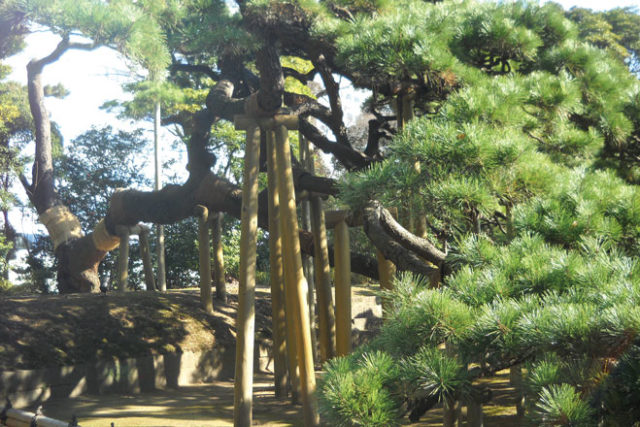By Yukiko Tanaka
For The North American Post
Right before Sumida River flows into Tokyo Bay, passing Tsukiji Market, is an expansive, open space of greenery. It is a garden referred to as Former Hama Detached Palace Garden. In the garden are several ponds, some of which have water from the Sumida flowing in them. While one side of the garden faces the river with a low concrete dike, two other sides are along canals. Despite being in the middle of downtown Tokyo, this Detached Palace Garden is a quiet place with water, trees and open spaces dotted with tea houses. Since you are close to it, you should stop here after you visit the Fish Market. No doubt, you will feel you are in a different world.
Retrace a bit northwest first to reach Shinohashi–dori, or directly from Ginza you might take Hanatsubaki-dori near 8-chome down East and South. You will reach an entrance to the garden that is by Shiodome subway station (near JR’s Shinbashi Station). It is a bit out of your way to the final destination of the day but it is well worth it. You can also get there via waterway: a sightseeing boat that leaves at the South end of Asakusa Park lets you off near the entrance to the garden.
There are several gardens in central Tokyo in various locations and with different histories. Although they used to belong to powerful domains or royal families, they now belong to its citizens and are managed by the municipality. This former Hama Detached Garden, the origin of which is in the early Edo period, is very old. Primarily a marshy land, the site was once a duck hunting ground. The Tokugawa’s fourth shogun ordered to make it a ground for hunting with hawks by reclaiming some land and building houses. The shoguns used it as a villa as well. Not far from the Castle (the Palace), it is used by royal families and diplomats to entertain special foreign guests today; in 1950, it joined Tokyo’s other gardens which are open to the public. That Tokyo has parks like this (others are Hibiya and Ueno Park), access to which is very good, I think, makes it one of the world’s greatest cities.
Three tea houses that stand in the garden and the bridges over its ponds are of excellent architectural work. Flowers bloom here all year round and you can enjoy not only blossoms of plums and peonies but also fields of pink primroses and yellow rape flowers in patches. Noteworthy is an ancient-looking pine tree by the entrance, whose branches are stretching low near the ground. It was planted by one of the shoguns 600 years ago. When you look up you see high-rises on three sides of the area looking down into the garden, but despite them and a raised expressway that goes by on one side it is remarkably quiet due to its size. Although it is not well known, special New Years events take place (on the 2nd and 3rd day of January) in Tokyo’s public parks. In Hama Detached Palace Garden the demonstration of hunting with hawks takes place. A sport brought to Japan from the continent in the 4th Century, it is a hunt in which trained hawks catch wild animals. Long enjoyed by emperors and prominent feudal lords, the hunt was a preferred sport of Tokugawa Ieyasu. Today there are even some women among taka-shi, or hawkers. I saw it demonstrated in front of visitors and found it a treat. The fact that New Years events take place in some Tokyo parks is not well-known and comes as a surprise to me, considering that the same days see a maddening crowd descending upon the compound of Meiji Shrine.
In a ten minute walk southward you see another garden that is under Tokyo municipality’s management—Former Shiba Garden. Owned by one of the provincial lords and created during the early years of the Edo period, its significance lies in the fact that very little has changed since, although one obvious difference is that there are now high-rises surrounding it preventing sight, beyond the ocean, of the tip of Boso Peninsula (Chiba Prefecture). Seeing this garden after the spectacular Hama Detached Garden is a bit of letdown, but it is here I saw the performance of an ancient type of kabuki put on stage by a group of student musicians and dancers. If you happen to be in Tokyo during New Year’s, make a point of going to these parks and enjoy free performances (admission to the parks is 300 yen, for seniors it is half).
[Editor’s Note]
This series will be published every week. The writer can be reached atytanaka03@gmail.com.







